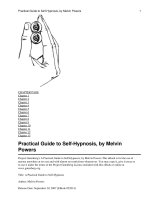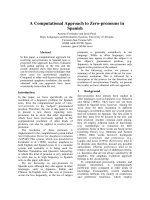A CITIZENS’ GUIDE TO ENERGY SUBSIDIES IN INDONESIA doc
Bạn đang xem bản rút gọn của tài liệu. Xem và tải ngay bản đầy đủ của tài liệu tại đây (1.82 MB, 36 trang )
A CITIZENS’ GUIDE
TO ENERGY SUBSIDIES
IN INDONESIA
PRODUCED BY THE INTERNATIONAL INSTITUTE FOR SUSTAINABLE DEVELOPMENT'S
GLOBAL SUBSIDIES INITIATIVE AND THE INSTITUTE FOR ESSENTIAL SERVICES REFORM WWW.IISD.ORG
IISD contributes to sustainable development by
advancing policy recommendations on international
trade and investment, economic policy, climate
change and energy, measurement and assessment,
and natural resources management, and the enabling
role of communication technologies in these areas.
We report on international negotiations and
disseminate knowledge gained through collaborative
projects, resulting in more rigorous research, capacity
building in developing countries, better networks
spanning the North and the South, and better global
connections among researchers, practitioners, citizens
and policy-makers.
IISD’s vision is better living for all—sustainably; its
mission is to champion innovation, enabling societies to
live sustainably. IISD is registered as a charitable
organization in Canada and has 501(c)(3) status in the
United States. IISD receives core operating support from
the Government of Canada, provided through the
Canadian International Development Agency (CIDA), the
International Development Research Centre (IDRC) and
Environment Canada, and from the Province of Manitoba.
The Institute receives project funding from numerous
governments inside and outside Canada, United Nations
agencies, foundations and the private sector.
International Environment
House 2
9 chemin de Balexert
1219 Châtelaine
Geneva, Switzerland
Tel: + (41-22) 917-8683
International Institute for Sustainable Development
161 Portage Avenue East
6th Floor
Winnipeg, Manitoba
Canada R3B 0Y4
Tel: +1 (204) 958-7700
www.iisd.org/gsi
Table of Contents
1. An Overview of Indonesia’s Energy Subsidies 4
1.1 What is an Energy Subsidy? 6
1.2 Why Subsidize Energy? 7
1.3 Indonesia’s Energy Subsidies 7
1.3.1 Gasoline and Diesel Oil 7
1.3.2 Kerosene 9
1.3.3 Liquefied Petroleum Gas 10
1.3.4 Electricity 10
1.3.5 Coal 11
1.3.6 Upstream Oil and Gas Subsidies 12
2. Are Energy Subsidies Good for Indonesians? 14
2.1 Do Poor People Benefit? 14
2.2 Are Energy Subsidies Good for Economic
Development? 16
2.2.1 Fuel Price Volatility and Government
Financing 17
2.2.2 Increased Energy Imports 17
2.2.3 Investment 18
2.2.4 Competition 18
2.2.5 Corruption and Smuggling 18
2.3 What about the Environment? 19
2.4 Who Would be the Winners and Losers
from Energy Subsidy Reform? 20
2.5 What Plans has the Indonesian Government
Announced to Reform Subsidies? 21
3. What do We Know about Reform of Energy
Subsidies 24
3.1 Policies to Support Poor Households 24
3.2 Good Processes to Support Reform 26
3.2.1 Communication 26
3.2.2 Gradual Phase-Out 27
3.2.3 Monitoring and Adjustment 27
3.3 Conclusion 28
4. Endnotes 29
5. References 30
Acknowledgements 34
AN OVERVIEW OF
INDONESIA’S ENERGY
SUBSIDIES
4
SECTION ONE | AN OVERVIEW OF INDONESIA’S ENERGY SUBSIDIES
1. An Overview of Indonesia’s Energy Subsidies
The Government of Indonesia, like many countries around the world, has used subsidies for decades
to promote a range of social and economic objectives. Among the priorities vying for support are
poverty alleviation, infrastructure development, health and education. Given the competing
demands, deciding where to allocate public financial resources is one of the government’s most
important and difficult tasks.
Citizens have a vital stake in these decisions, but unfortunately there is often little public debate
about what should be subsidized, or information about the costs and who benefits. This is partly a
problem of transparency: in many cases subsidies are hidden and difficult to track. But it is also
because regular citizens are busy making livings and raising families, with little time to devote to
monitoring their government’s every activity.
Yet, if subsidies are to provide a genuine benefit, it is vital for the public to have effective oversight
of government expenditure—a task that falls in large part to civil society groups and journalists, the
intended audience of this guide.
The following pages gather the best available information on the costs and benefits of energy
subsidies. Why focus on energy subsidies? First, subsidies for fuels and electricity receive huge
amounts of public support in Indonesia. In fact, the government spends more on subsidies to fuel
than it does on capital expenditure for public infrastructure (see Box 1). Second, these subsidies
have major impacts on social equity, economic growth and environmental preservation:
the three pillars of sustainable development.
The first part of this guide provides an overview of how various types of energy are subsidized in
Indonesia. The second part looks at the implications of these subsidies on various aspects of
sustainable development. The third part discusses the process of reforming energy subsidies,
drawing on Indonesia’s earlier efforts, and lessons learned from other countries.
The government spends more on subsidies to fuel than
it does on capital expenditure for public infrastructure.
[]
A CITIZENS’ GUIDE TO ENERGY SUBSIDIES IN INDONESIA 5
SECTION ONE | AN OVERVIEW OF INDONESIA’S ENERGY SUBSIDIES
Did you know that the government spends the same on
energy subsidies as it does on defence, education, health
and social security combined?
Up until 2010, the Indonesian government spent more on energy subsidies than it spent on defence,
education, health and social security combined. Before 2009, the government spent more on
energy subsidies than it did on capital expenditures such as public infrastructure, transportation
systems, and water and sanitation facilities. More recently, the government has increased its
spending in other areas but energy subsidies remain very high by comparison.
Table 1» Government expenditures and subsidies (2005–2011) (in trillion Rupiahs [Rp])
1
Trillion Rupiahs (Rp) 2005 2006 2007 2008 2009 2010 2011
LKPP LKPP LKPP LKPP LKPP APBN-P RAPBN APBN
Total Expenditures 361 440 505 693 629 782 824 837
All Subsidies 121 108 150 275 138 201 185 188
• Energy Subsidies 105 95 117 223 95 144 134 137
– Fuel Subsidies 96 64 84 139 45 89 93 96
– Electricity Subsidies 9 31 33 84 50 55 41 41
Capital Spending
(Investment) 33 55 64 73 76 95 122 136
Defense 22 24 31 9 13 21 45 47
Education 29 45 51 55 85 97 82 92
Health 6 12 16 14 16 20 13 14
Social Security 22333445
Source: Data Pokok APBN 2011 (Ministry of Finance)
Note: LKPP, or Central Government Financial Report, refers to the actual government spending. APBN refers to the government budget
(agreed on a particular year), and APBN-P refers to the revision of the government budget. Energy subsidies are allocated in the
budget, but the actual spending of the subsidies are reported in LKPP.
BOX 1
6
SECTION ONE | AN OVERVIEW OF INDONESIA’S ENERGY SUBSIDIES
1.1 What is an Energy Subsidy?
Commonly, energy subsidies are defined as “any government action that lowers the cost of energy
production, raises the revenues of energy producers or lowers the price paid by energy consumers”
(IEA, OECD and the World Bank 2010). Energy subsidies come in two main categories: those designed
to reduce the cost of consuming energy, called consumer subsidies, and those aimed at supporting
domestic production, called producer subsidies (Burniaux et al., 2009 cited in Ellis, 2010).
In practice, energy subsidies come in different forms. The OECD/IEA (2002) and UNEP (2008) identify the
following typical mechanisms by which governments support the production and consumption of energy:
• Direct financial transfers: grants to consumers, grants to producers, low-interest or
preferential loans and government loan guarantees;
• Preferential tax treatment: tax credits, tax rebates, exemptions on royalties, duties or
tariffs, reduced tax rates, deferred tax liabilities and accelerated depreciation on
energy-supply equipment;
• Trade restrictions: tariffs, tariff-rate import quotas and non-tariff trade barriers;
• Energy-related services provided directly by government at less than full cost:
government-provided energy infrastructure, public research and development;
• Regulation of the energy sector: demand guarantees, mandated deployment rates,
price controls, environmental regulations and market-access restrictions.
The benefits of energy subsidies typically accrue to
wealthier classes of citizens, as they use more energy.
[]
A CITIZENS’ GUIDE TO ENERGY SUBSIDIES IN INDONESIA 7
SECTION ONE | AN OVERVIEW OF INDONESIA’S ENERGY SUBSIDIES
1.2 Why Subsidize Energy?
Policy-makers often justify energy subsidies with the argument that they contribute to economic
growth, poverty reduction and security of supply (IEA, OPEC, OECD and World Bank 2010). It is true
that subsidies can be an important policy to promote social welfare and address market failures.
However, there are also risks associated with subsidizing energy. Artificially low prices potentially
discourage energy conservation, and fossil fuel subsidies are a disincentive to shifting to cleaner
sources of energy. Moreover, the benefits of energy subsidies typically accrue to wealthier classes of
citizens, as they use more energy. These and other impacts of energy subsidies are discussed in
more detail in the second section of this guide.
1.3 Indonesia’s Energy Subsidies
1.3.1 Gasoline and Diesel Oil
The Indonesian government subsidizes two petroleum products of the state owned oil company,
Pertamina: gasoline fuel called “Premium” and diesel oil called “Solar”; the latter is used for public
services, transportation, fisheries and small-and medium-sized enterprises. The retail prices of
these products are regulated at below their actual market prices. The government no longer
subsidizes petroleum for industrial consumption.
Indonesia has been subsidizing the retail price of fuels since 1967 (Dillon et al., 2008). During the
1980s, when Indonesian’s oil production was higher, fuel subsidies were more affordable, although
they were broadly criticized for their distorting effect on the economy. When global oil prices
soared in 2005, the government spent 24 per cent of total expenditure on subsidies and of that,
90 per cent was for fuel products (World Bank, 2007). To reduce its expenditure, the government
raised the domestic prices of kerosene, gasoline and diesel twice in a six-month period in 2005.
The first increase, in March, raised fuel prices by 29 per cent, and the second fuel prices increase,
in October, by 114 per cent (World Bank, 2007).
8
SECTION ONE | AN OVERVIEW OF INDONESIA’S ENERGY SUBSIDIES
Table 2 » Domestic Fuel Prices vs. International Prices
Before October Fuel After October Fuel Fuel Price in
Increase (Sept 05) Increase (Oct 05) September 06
A. Domestic Fuel Price (Rp)
Gasoline 2,400 4,500 4,500
Kerosene 700 2,000 2,000
Diesel Oil 2,100 4,300 4,300
B. International Price (Rp) *
Gasoline 6,570 5,876 4,509
Kerosene 6,493 6,218 5,808
Diesel Oil 6,470 6,225 5,545
C. Domestic Prices as % of
International Price (A/B)
Gasoline 37 77 87
Kerosene 11 32 31
Diesel Oil 32 69 67
D. Economic Variables
Crude oil price (ICP, US$/bbl) 62 58 63
Exchange rate (Rp/US$) 10,310 10,090 9,235
* MOPs plus 15 percent adjusted by exchange rate and tax.
Source: processed from Data Pokok APBN 2005-2011 (Ministry of Finance, 2010)
Again, in 2008, record prices for crude oil—almost US$145 a barrel—pressured the Indonesian
government to increase the price of petroleum and diesel oil. However, when the price of crude oil
came down in January 2009, the government reduced the price of gasoline (Premium) and diesel oil.
2
In 2010, the government considered limiting the distribution of subsidized fuel in order to cut the cost
of subsidies. However, this policy was still under development in late 2010. Escalating oil prices in 2011
may, once again, boost the government’s spending on fuel subsidies.
A CITIZENS’ GUIDE TO ENERGY SUBSIDIES IN INDONESIA 9
SECTION ONE | AN OVERVIEW OF INDONESIA’S ENERGY SUBSIDIES
96
52
LKPP
2005
Fuel Subsidy (Trillion Rp)
Assummed Oil Price by Government (US$/barrel
64 64
LKPP
2006
84 70
LKPP
2007
139
97
LKPP
2008
45
62
LKPP
2009
89
80
APBN-P
2010
93
80
2011
96
80
RAPBN APBN
Source: processed from Data Pokok APBN 2011 (Ministry of Finance, 2010)
Note: LKPP, or Central Government Financial Report, refers to the actual government spending. APBN refers to the government budget
(agreed on a particular year), and APBN-P refers to the revision of the government budget. Energy subsidies are allocated in the
budget, but the actual spending of the subsidies are reported in LKPP.
Figure 1 » Fuel subsidy and assumed oil price by the Government of Indonesia
1.3.2 Kerosene
The government of Indonesia regulates the price of kerosene, keeping the retail price below the
market price. The government reformed kerosene subsidies in mid-2005, removing the subsidy for
industrial consumers; however, kerosene for households and small- and medium-enterprises
(SMEs) is still subsidized. Kerosene is mainly used for household cooking and lighting. In 2007 the
government introduced its kerosene-to-LPG conversion program, which further reduced the
kerosene subsidies. In 2006, the government budgeted Rp31.5 trillion (US$3.5 billion) for kerosene
subsidies, Rp36.5 trillion (US$4 billion) in 2007 and Rp38 trillion (US$3.8 billion) in 2008.
3
10
SECTION ONE | AN OVERVIEW OF INDONESIA’S ENERGY SUBSIDIES
1.3.3 Liquefied Petroleum Gas (LPG)
Facing fiscal pressure from high kerosene subsidies, the Government of Indonesia started a
kerosene-to-LPG conversion program to reduce the kerosene subsidy in 2007. The program provides
a free start-up package consisting of a 3 kg LPG tank, a compact LPG stove and its accessories
(regulator and hose). Originally, the plan was to roll the program out to 42 million households and
small enterprises by 2012 in an effort to replace more than 6 million kiloliters of kerosene annually.
The target has since been increased to 48 million start-up packages.
The Ministry of Energy and Mineral Resources has estimated that the total cost for distributing 46 million
start-up packages of 3 kg LPG tanks from 2007 to 2011 will amount to Rp14.11 trillion (US$1.56 billion). But
it would save up to Rp35.34 trillion (US$3.9 billion) by reducing the kerosene subsidy (Evita Legowo,
Director General of Oil and Gas, cited in Investor Daily Indonesia, 2011). The cost of start-up and
distribution are covered by the annual state budget. In late 2010, the Ministry of Finance announced a
Ministerial Decree that grants a Value-Added Tax (VAT) exemption for government subsidies on
3 kg LPG tank products.
4
In addition to the free start-up package, the government also subsidizes the price of LPG for the
3 kg cylinder tank. In 2007, Ministry of Energy and Mineral Resources (MEMR) estimated that the
production cost of one kilogram of LPG is Rp6, 700. The subsidized price (before tax) for a 3 kg
cylinder tank is Rp3,500/kg, meaning each kilogram of LPG is subsidized by Rp3,200. Currently,
the selling price after tax is Rp4, 500/kg, so 3 kg LPG costs about Rp13, 500/tank (MEMR, 2007).
It is unclear for how long the government will keep subsidizing the 3 kg LPG tank.
1.3.4 Electricity
The Indonesian government sets the electricity tariff for all consumer types (i.e. industry, business,
residential and public services). The amount of subsidy is determined annually by the government,
based on the difference between the average cost of electricity production proposed by Perusahaan
Listrik Negara (PLN), the State-owned electric company, and the average electricity tariff set by the
government. The average cost of electricity production is based on an estimate of the composition
of the energy inputs for generating electricity and the power plants, transmission, distribution and
supply costs, and a margin for PLN.
A CITIZENS’ GUIDE TO ENERGY SUBSIDIES IN INDONESIA 11
SECTION ONE | AN OVERVIEW OF INDONESIA’S ENERGY SUBSIDIES
Subsidies for electricity jumped from Rp9 trillion (US$0.9 billion) in 2005 to Rp31 trillion (US$3.4 billion)
in 2006 due to increasing international crude oil prices and high diesel oil consumption in electricity
generation. In 2008, the subsidy for electricity skyrocketed to its highest cost at Rp84 trillion
(US$8.4 billion) (Ministry of Finance, 2010b).
1.3.5 Coal
The Indonesian government subsidizes coal in two ways: through guaranteed supplies to the State-owned
electricity company and domestic industries, and through regulating the domestic price of coal.
A coal subsidy is provided by way of a Domestic Market Obligation (DMO) policy, which sets a
guaranteed amount of coal sales to electricity generation and domestic industries. The formulation
of the DMO is primarily driven by the quantities of coal required by nominated domestic consumers
to satisfy their annual operating requirements.
The DMO is distributed proportionally to the coal companies through their Work Budget and
Program (CCoWRKAB) approval. The quota is recalculated and set annually, reflecting the change in
demand and supply of coal. For instance, the coal DMO for 2009 was 68 million tons, and in 2010,
it was 70 million tons.
In addition to the DMO policy, the government also sets the Indonesian Coal Price Reference
(ICPR). The price setting aims to secure domestic coal supply, act as a reference price for
producers and domestic consumers, and maximize the state revenue from coal. ICPR makes coal
prices relatively uniform. The procedure to set ICPR is determined by the Minister of Energy and
Mineral Resources Decree No. 17/2010. The determination is based on a formula and several
attributes that might lower the domestic price below other international coal market indexes,
such as Global Coal and Barlow Jonker.
5
The major consumer of coal in Indonesia is the State-owned electricity company, PLN. The
company consumes more than 80 per cent of domestic coal supply or about 34 million tons in
2010. The remaining coal is consumed by domestic industries such as steel and cement.
12
SECTION ONE | AN OVERVIEW OF INDONESIA’S ENERGY SUBSIDIES
1.3.6 Upstream Oil and Gas Subsidies
The government provides several subsidies for oil and gas exploration and production activities in
the form of tax incentives, an investment credit allowance and the oil domestic market obligation.
Braithwaite et al. (2010) calculated that, in 2008 alone, oil and gas producers received about
US$245 million (Rp2.37 trillion) in investment credit and tax incentives. In addition, Pertamina’s
refineries benefit from buying crude oil supplied to them through the oil domestic market
obligation system at heavily discounted prices. This subsidy to Pertamina was worth, US$1.55 billion
(Rp15 trillion) in 2008, to make the total subsidy value to upstream oil and gas worth US$1.8 billion
(Rp17 tillion) in 2008. Moreover, the study identified several other potential subsidies; however,
the information required to clarify and estimate these subsidies was not readily available.
ARE ENERGY SUBSIDIES
GOOD FOR INDONESIANS?
14
SECTION TWO | ARE ENERGY SUBSIDIES GOOD FOR INDONESIANS?
2. Are Energy Subsidies Good for Indonesians?
The Indonesian government subsidizes fuel and electricity to help keep energy affordable,
especially for low-income groups (Ministry of Finance, 2010b). Energy subsidies are intended to
increase household incomes in two ways. The direct effect is that, by paying less for fuel,
households have more disposable income to spend on other things. The indirect effect is that the
goods and services purchased by households might be cheaper as a result of subsidies that reduce
energy input costs for producers, distributors and service providers.
2.1 Do Poor People Benefit?
In actual fact, several studies show that most of the benefits of fuel subsidies are harnessed by
high-income groups. Because fuel subsidies are provided per litre, and do not vary depending on
income, those who consume the most fuel receive the largest share of the subsidy. The largest
consumers of energy are the wealthiest households and those in urban areas.
The World Bank (2011) used data from the 2009 Indonesian National Household Socioeconomic
Survey (SUSENAS) to show that households and private uses may account for around a third of
subsidized fuel consumption. The remainder appears to be used commercially for transport, such as
by buses and businesses (Figure 2). The study also found that the top half of households by wealth
consumed 84 per cent of the subsidized gasoline, with the richest decile alone accounting for
almost 40 per cent. In contrast, the poorest decile accounted for less than 1 per cent of subsidized
gasoline use. Further detailed examination of household survey data suggested that about two
thirds of the poor and near-poor households (defined as the bottom 5 deciles) do not consume
gasoline whatsoever.
90 per cent of Indonesia’s fuel subsidies
benefit the richest 50 per cent of households.
[]
A CITIZENS’ GUIDE TO ENERGY SUBSIDIES IN INDONESIA 15
SECTION TWO | ARE ENERGY SUBSIDIES GOOD FOR INDONESIANS?
Commercial
Users
54%
Private
Consumption
(by households)
46%
Source: World Bank (2011, p. 27)
Figure 2 » Share of subsidized consumption gasoline attributed to commercial and
private consumption
Similar results have been found by other researchers. Agustina et al. (2008), for example, found
that more than 90 per cent of Indonesia’s fuel subsidies benefit the richest 50 per cent of
households (Figure 3). The Indonesian government is aware of these effects. The Coordinating
Ministry of Economic Affairs advised in May 2008 that the wealthiest 40 per cent of families receive
70 per cent of the subsidies, while the bottom 40 per cent benefit from only 15 per cent of the
subsidies (Mourougane, 2010).
16
SECTION TWO | ARE ENERGY SUBSIDIES GOOD FOR INDONESIANS?
1 2 3 4 5 6 7 8 9 10
50%
40%
30%
20%
10%
0%
Poor Household Consumption Decile
Percentage of subsidy received
Wealthy
Source: Agustina et al., 2008
Figure 3 » The distribution of fuel subsidies across Indonesian households
2.2 Are Energy Subsidies Good for Economic Development?
Fuel subsidies affect the economy in several ways. A readily observable effect is the cost on the
government budget, but there are more subtle and equally important impacts on the economy.
By artificially lowering the price of certain types of energy, subsidies encourage overconsumption
and inefficient use of those resources. Lower prices also alter investment decisions by discouraging
energy diversification and reducing the incentive for energy suppliers to build new infrastructure.
The key economic impacts of fuel subsidies are discussed below.
6
Large subsidies on imported oil make Indonesia’s fiscal position
highly vulnerable to changes in global energy prices.
[]
A CITIZENS’ GUIDE TO ENERGY SUBSIDIES IN INDONESIA 17
SECTION TWO | ARE ENERGY SUBSIDIES GOOD FOR INDONESIANS?
2.2.1 Fuel Price Volatility and Government Financing
As a net fuel importer, Indonesia must buy most of its fuel at international market prices. Selling
that fuel more cheaply domestically results in huge losses for Pertamina that must be funded by
the government (i.e., the taxpayer), resulting in a major financial burden on the whole economy.
Large subsidies on imported oil make Indonesia’s fiscal position highly vulnerable to changes in
global energy prices. When international oil prices rise dramatically, like they did in 2008, the
government is forced to either drastically increase prices—which can be politically difficult and
cause a sudden rise in inflation—or make corresponding increases to its subsidy budget, which can
be crippling for the economy.
If the government chooses to maintain subsidies at times of high oil prices, it must borrow the
additional funds or cut expenditures to other programs. The volatile oil market and uncertainty
about the government’s financing needs increases the cost of government borrowing, adding to
future debt repayments (World Bank, 2011). Cutting spending on infrastructure, health or education
will also have long-term negative impacts on development and economic competitiveness.
2.2.2 Increased Energy Imports
Overconsumption of subsidized energy leads to an increased demand for imported fuel and a
reduction in the amount of domestically produced energy available for exports. Subsidies can thus
result in a deterioration of the balance of payments and increase the country’s dependence on
energy imports (Mourougane, 2010).
A large disparity between subsidized and non-subsidized fuel encourages consumers to switch from
Pertamina’s non-subsidized “Pertamax” fuel (octane 92) to subsidized “Premium” fuel (octane 88).
In the first quarter of 2011, the government reported that sales of subsidized fuel (Premium)
surpassed the quota by an average of 7 per cent, while Pertamax sales dropped approximately
11 per cent (Jakarta Post, 2011b; Jakarta Post, 2011e; Kontan, 2011). The Indonesian Downstream Oil
and Gas Regulatory Agency (BPH Migas) predicts that the quota of 38.5 million kiloliters of Premium
for 2011 will be exceeded by up to 3.5 million kiloliters (Jakarta Post, 2011d). Pertamina’s refineries
are only capable of producing 10.58 million kiloliters of “Premium” fuel annually, and therefore the
remaining amount of fuel must be imported to meet domestic demand (Detik Finance, 2011).
18
SECTION TWO | ARE ENERGY SUBSIDIES GOOD FOR INDONESIANS?
2.2.3 Investment
For energy providers, such as petroleum refining facilities or electricity generators, mandated low
prices mean that there is less incentive to invest in new capital, due to lower expected returns.
This is true in Indonesia, where subsidies have led to deterioration in the financial situation of state-
owned energy companies and under-investment in infrastructure (Mourougane, 2010). In 2009 the
revenue from the sale of electricity by the State-owned power company, PLN, was only around half
of the cost of supply (on average Rp650 per kWh and Rp1,300 per kWh, respectively).
Compensation received from the central government was insufficient to fill this gap. As a result, PLN
has been unable to fund new investment, expand electrification in rural areas and sometimes even
to conduct standard maintenance (Mourougane, 2010). The result has been a lack of development of
its generating capacity and frequent blackouts.
2.2.4 Competition
Artificially low prices for fossil fuels make it harder for alternative energy sources to compete
commercially. These alternative sources could ultimately become more economically and
environmentally attractive, but are disadvantaged by the subsidies provided to their competitors.
Subsidies can thus “lock in” existing technologies to the exclusion of other, more promising ones.
2.2.5 Corruption and Smuggling
The price disparity created between subsidized and non-subsidized products can create a strong
incentive for illegal practices such as fuel smuggling and diversion to unintended recipients. The
production side of fossil fuels is a highly lucrative business and subject to government oversight
that can be vulnerable to bribery. Six areas of particular vulnerability have been identified:
underpayment of royalties, awarding licenses for oil and gas extraction, irregularities in State-owned
enterprises, distribution of profits in production-sharing arrangements and the exploitation of
loopholes in new subsidy schemes (Global Subsidies Initiative, 2010). In the case of LPG in
Indonesia, the price difference between a subsidized 3 kg LPG tank and a non-subsidized 12 kg LPG
tank encourages the illegal transfer of the content of 3 kg tanks into 12 kg tanks. Without the proper
refilling process, this is extremely dangerous and has caused explosions that have injured and killed
hundreds of people (KOMPAS, 2010; KOMPAS, 2011a).
A CITIZENS’ GUIDE TO ENERGY SUBSIDIES IN INDONESIA 19
SECTION TWO | ARE ENERGY SUBSIDIES GOOD FOR INDONESIANS?
Growing retail price disparity has increased fuel smuggling and illegal selling of subsidized fuel.
The Downstream Oil and Gas Implementing Agency (BPH Migas) reported that between 10 and 15
per cent of the subsidized fuel distributed by the government was illegally sold to industries,
particularly at gas stations close to industrial and mining areas (Jakarta Post, 2011h). This increase
in illegal selling and smuggling of fuel has led to an increase in the demand of subsidized fuel.
BPH Migas predicts that subsidized fuel consumption might reach 40 million kiloliters by the end of
2011, exceeding the quota by 4 per cent (Jakarta Post, 2011g).
Controlling illegal activities incurs large administrative costs to prevent, monitor and deal with
abuse. Such costs add to the subsidy budget that is shared by all taxpayers.
2.3 What about the Environment?
Energy subsidies encourage excessive consumption and reduce incentives for energy efficiency.
The logical consequences of high fossil fuel consumption are greater greenhouse gas emissions,
local air pollution and resource depletion. Based on data from the International Energy Agency
(IEA), phasing out consumption subsidies for fossil fuels between 2011 and 2020 would cut global
CO
2
emissions by 5.8 per cent, compared with a “business as usual” scenario (IEA, 2010). The
Organisation for Economic Co-operation and Development (OECD) estimates that emissions
reductions could be as high as 10 per cent by 2050 if the same subsidies for fossil fuel consumption
are removed by 2020 (IEA, OPEC, OECD, World Bank 2010). Eliminating fossil fuel subsidies provides
a way for countries like Indonesia to make a major contribution to greenhouse gas reduction
without introducing carbon taxes or an emissions trading system. Yusuf et al. (2010) found that
removing fuel and electricity subsidies would reduce national CO
2
emissions by 6.66 per cent by
2020 (5.79 per cent from removal of fuel subsidies; 0.92 per cent from removal of electricity subsidies).
The logical consequences of high fossil fuel
consumption are greater greenhouse gas emissions,
local air pollution and resource depletion.
[]
20
SECTION TWO | ARE ENERGY SUBSIDIES GOOD FOR INDONESIANS?
Subsidies also undermine the incentive to invest in existing cleaner energy sources and technologies
by artificially reducing the consumer price for fossil fuel products. In the same way, fuel subsidies
discourage innovation in the production and deployment of cleaner types of energy, such as LPG and
renewables, even though Indonesia’s endowment in these energy resources is substantial.
2.4 Who Would be the Winners and Losers if Energy Subsidies
were Removed?
As noted above, the benefits of fuel subsidies accrue mainly to high-income groups and their cost
falls on the whole taxpaying population. As a result, fuel subsidies are a regressive policy, with poor
households paying relatively more and receiving fewer benefits than wealthier ones. The removal
of subsidies would therefore have long-term economic benefits for the economy as a whole,
including the poor.
Nonetheless, removal of subsidies would have some short-term negative impacts on some groups.
Economic modelling by Clements, Jung and Gupta (2007) found that those most impacted by the
reduction of subsidies in Indonesia would be high-income groups in urban and rural environments
as they consume the most petroleum products. These groups would most likely reduce their overall
consumption in the short-term in order to manage higher fuel prices.
In general, rural and lower-income groups consume a larger portion of agricultural goods, whose
price is less sensitive to changes in fuel price. However, the urban poor were also found to be
vulnerable to fuel price rises (Clements, Jung and Gupta, 2007). This is probably because, compared
with the rural poor, they are more likely to rely on utilities (such as electricity) and their
employment is capital-intensive (i.e., it relies on energy-intensive machinery).
In the longer term, a higher petroleum price is unlikely to have harmful effects on the poor because
it would be compensated by the economy-wide benefits of subsidy reduction: improved fiscal
sustainability, increased social spending by the government, more efficient allocation of resources
and increased investment (Clements, Jung and Gupta, 2007).
A CITIZENS’ GUIDE TO ENERGY SUBSIDIES IN INDONESIA 21
SECTION TWO | ARE ENERGY SUBSIDIES GOOD FOR INDONESIANS?
2.5 What Plans has the Government Announced to Reform
Energy Subsidies?
The government has repeatedly publicized plans to reduce fuel subsidies but has delayed
implementation. Most recently, the government announced a plan in 2010 to raise electricity prices
and limit fuel subsidies. The measure would have restricted private cars from buying subsidized fuel
from April 2011 for the Greater Jakarta area. Only public transportation would be entitled to
subsidized fuel. In 2012, subsidies were to be further reduced (Wei, 2011). However, the plan was
postponed indefinitely (Jakarta Post, 2011c).
In March the government’s Fuel Subsidy Assessment Team recommended three options to limit
sales of subsidized fuel. The first option is to impose a price cap of Rp8,000 (US$0.91) per litre for
non-subsidized Pertamax gasoline to ensure that private car owners would not be negatively
affected if the fuel price continues to rise. The second option is to raise the price of the subsidized
Premium gasoline by Rp500 per litre from the current Rp4,500 per litre. The third option is to limit
the allocation of Premium gasoline through an allotment system to better target the sales of
subsidized fuel (Jakarta Post, 2011a).
In May 2011 the government announced that fuel subsidies will be retained but the distribution
mechanism will be changed to a direct and targeted subsidy. A roadmap for the reform will be
announced in July 2011 (KOMPAS, 2011b).
The government of Indonesia has been trying to reduce subsidies for electricity by increasing tariffs.
In July 2010 the government increased the electricity tariff by 18 per cent on average for most PLN
consumers, excluding 33.6 million small residential consumers with a 450 and 900 Volt-Amper (VA)
connection. Despite the tariff increase, in 2010, electricity subsidies still exceeded the target by
Rp2.5 trillion, totalling Rp57.6 trillion (US$6.4 billion).
7
In May 2011 the government announced a plan to increase the base price of the electricity tariff by
between 10 to 15 per cent in 2012, with expected savings of Rp15 trillion (US$1.65 billion) for the
state budget (Jakarta Post, 2011f). The plan is expected to be approved by Parliament as part of the
2012 budget.
22
SECTION TWO | ARE ENERGY SUBSIDIES GOOD FOR INDONESIANS?
The government has also announced a change to the distribution model for subsidized 3 kg LPG
canisters from the current open system to a closed system by 2014. The government intends to
introduce a control card, limiting subsidized 3 kg LPG canisters for poor families and small
businesses. The distribution of the control card will be based on data provided by local
governments and the government’s pilot projects in several regions, which were trialled in 2009
and 2010 (Republika, 2010). The kerosene-to-LPG conversion program is due to end in 2012 and
without limiting the LPG subsidy, the government could face increasing costs on completion of
the program.
WHAT DO WE KNOW
ABOUT THE REFORM OF
ENERGY SUBSIDIES?
24
SECTION THREE | WHAT DO WE KNOW ABOUT REFORM OF ENERGY SUBSIDIES
3. What do We Know about the Reform of Energy Subsidies?
Although many fuel subsidies help the rich more than the poor, we should not lose sight of the fact
that some poor households—especially those in urban areas—depend on subsidies to make energy
affordable. For these people, expenditure on energy takes up a larger portion of their budget than
it does for the wealthy. Energy price rises and possible inflation can put poor households under
severe financial stress.
But subsidy reform can be designed and implemented in a way that minimizes the negative
impacts for poor households. A suite of policies have been used by countries around the world,
including Indonesia, to ease the transition away from fuel subsidies. The policies can be grouped
into two categories: those that provide assistance to poor households and those that help the
broader community to understand and support reform. The best chance for successful reform
(which can be defined as the long-term elimination of subsidies with minimal negative impacts on
the poor and society at large) requires a comprehensive strategy drawing on a range of transitional
support policies (Laan, Beaton & Presta, 2010). Research into the nature of the subsidy, how its costs
and benefits are distributed, and identification of those most likely to be impacted by its removal
will help design the reform strategy.
3.1 Policies to Support Poor Households
Reducing energy subsidies would free-up government funds for other purposes. By allocating these
funds to programs that directly target the poor, the government would redirect money from fuel
subsidies (that mostly benefit the rich) to those most in need. There are two main ways that
governments can do this: cash transfers and increased social spending.
Indonesia has experience with both of these approaches. In 2005 and 2008, the Indonesian
government used the Cash Transfer Assistance program (Bantuan Langsung Tunai or BLT) to reduce
opposition to fuel price increases and help poor families cope with higher energy costs. The
A suite of policies have been used by countries
around the world, including Indonesia, to ease the
transition away from fuel subsidies.
[]
A CITIZENS’ GUIDE TO ENERGY SUBSIDIES IN INDONESIA 25
SECTION THREE | WHAT DO WE KNOW ABOUT REFORM OF ENERGY SUBSIDIES
program provided two payments of Rp.300,000 (around US$30) directly to poor families (Widjaja,
2009). The BLT was accompanied by short-term measures referred to as the Fuel Subsidy Reduction
Compensation Program (Program Konpensasi Pengurangan Subsidi Bahan Bakar Minyak or PKPS-
BBM). These programs provided targeted support for affected groups by increasing social spending
in the areas of education, health and rural infrastructure (Beaton & Lontoh, 2010).
In a review of these policies, Beaton and Lontoh (2010) considered that they were reasonably
successful in assisting poor households and reducing opposition to fuel price increases. According to
various reviews of the 2005 BLT program, mistargeting is thought to have been relatively low and the
majority of households did actually receive the funds they had been promised (Hastuti et al., 2006).
However, there were problems. Some cash transfers were misappropriated and some deserving
recipients did not receive payments, which resulted in social unrest (Cameron & Shah, 2011). Those
missing out on payments vented their frustration on the local administrators of the scheme, leading
in some cases to violence and the resignation of village officials. Any future implementation of the
BLT would need to take into account lessons learned from previous experience, such as the need for
better targeting, stronger oversight and greater support for village officials.
An alternative approach would be to link cash payments to behaviours that assist community
development. Conditional Cash Transfers (CCTs) require recipient families to commit to certain
activities, generally related to children’s health care and education. Mexico’s Oportunidades
program is one such scheme. It started with approximately 300, 000 beneficiary households in 1997
but covered 5 million households by 2009 (Fiszbein & Schad, 2009). Significant data collected over
the years indicate that the program has been successful in assisting the poor. Mexico’s program was
not coupled with reductions to fossil fuel subsidies, but it nonetheless provides an example of a
social safety net that could be used to compensate for fuel price increases while maximizing
development outcomes.
Alternative avenues for social spending (funded by subsidy elimination) can also be observed in
other countries. Jordan, for example, supported subsidy reform in 2008 by increasing the minimum
wage and providing a salary increase to low-paid government employees. A one-time bonus was
given to low-income government employees and pensioners and electricity tariffs were maintained
at low levels. In the same year, Thailand initiated a six-month B46 billion (US$1.3 billion) program to
help the poor in response to high international oil prices. The plan offered free electricity to those
consuming less than 80 kilowatt-hours a month (and half the cost for households consuming less









